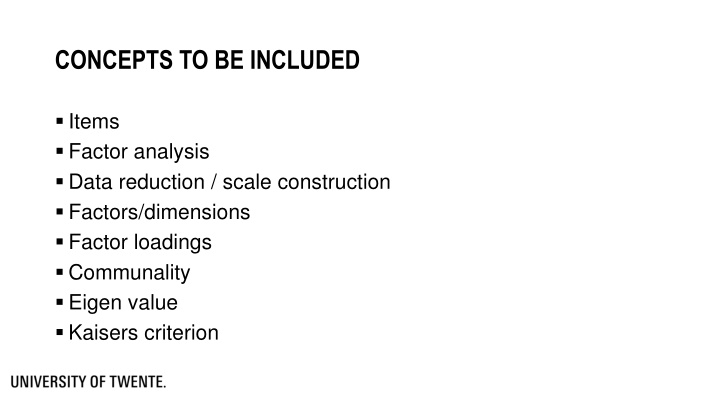CONCEPTS TO BE INCLUDED
Involves factor analysis, data reduction, factor loadings, eigenvalues, communality, the Kaiser criterion, and creating abstract scales. Learn about the Big Five personality traits and items measuring constructs like neuroticism and extraversion.
Download Presentation

Please find below an Image/Link to download the presentation.
The content on the website is provided AS IS for your information and personal use only. It may not be sold, licensed, or shared on other websites without obtaining consent from the author.If you encounter any issues during the download, it is possible that the publisher has removed the file from their server.
You are allowed to download the files provided on this website for personal or commercial use, subject to the condition that they are used lawfully. All files are the property of their respective owners.
The content on the website is provided AS IS for your information and personal use only. It may not be sold, licensed, or shared on other websites without obtaining consent from the author.
E N D
Presentation Transcript
CONCEPTS TO BE INCLUDED Items Factor analysis Data reduction / scale construction Factors/dimensions Factor loadings Communality Eigen value Kaisers criterion
AIM Reducing a set of (survey) items to a limited set of factors or dimensions, to create a few more abstract scales Extraction of factors Communality or items Eigenvalue or factors Selecting the number of factors using Kaiser s criterion
EXAMPLE: THE BIG FIVE NEO-PI-R personality scales measure five domains of personality Give an assessment of normal adult personality Are used in personality assessment
EXAMPLE: THE BIG FIVE Five constructs/dimensions/factors: Openness Conscientiousness Extraversion Agreeableness Neuroticism (closed minded intellectual curiosity) (sloppy/unreliable highly organized) (reflective attention seeking) (suspicious compassionate) (emotionally stable emotionally unstable)
ITEMS MEASURING ONE CONSTRUCT: NEUROTICISM Neuroticism (emotionally stable emotionally unstable) Items: Even minor annoyances can be frustrating to me Sometimes I feel completely worthless Extraversion (reflective attention seeking) I really enjoy talking to people Strongly Disagree 0 Disagree Neutral Agree Strongly agree 4 1 2 3
WHAT IS FACTOR ANALYSIS? A method to check whether latent factors (a.k.a. dimensions) are able to account for the correlation between sets of items Here: neuroticism and extraversion
Item 1 Concept 1 Correlation Item 2 No correlationx Item 3 Concept 2
Even minor annoyances can be frustrating to me Neuroticism x Sometimes I feel completely worthless x I really enjoy talking to people Extraversion
ONE FACTOR REPLACES ONLY TWO ITEMS Item 1 = a * Factor(N) + 0*Factor(E) Item 2 = b * Factor(N) + 0*Factor(E) Item 1 Concept Suppose perfect correlation = 1 x Item 2 Suppose absolutely no correlation = 0 Concept Item 3
THREE ITEMS, EXPLAINED BY TWO FACTORS Two items can be replaced by factor(N), but we need a factor(E) to explain item 3 Item 1 = 1*Factor(N) + 0*Factor(E) Item 2 = 1*Factor(N) + 0*Factor(E) Item 3 = 0*Factor(N) + 1*Factor(E) Factor loadings
THREE ITEMS, EXPLAINED BY TWO FACTORS Correlations are never perfect or completely absent, so factor loadings are somewhere between 0 and 1 Factor loadings For example: Item 1 = 0.8*Factor(N) + 0.1*Factor(E) Item 2 = 0.7*Factor(N) + 0.2*Factor(E) Item 3 = 0.1*Factor(N) + 0.9*Factor(E)
MANY FACTORS, MANY ITEMS Item O1 Item O2 Item O3 Item C1 Item E1 Item A1 Item N1 Item N2 Item N3 Openness Conscientiousness Extraversion Agreeableness Neuroticism
FACTOR MATRIX Fact 1 Fact 2 Fact 3 Fact 4 Fact 5 Fact 6 Fact 7 Fact 8 Fact 9 Item 1 Item 2 Item 3 Item 4 Item 5 Item 6 Item 7 Item 8 Item 9 Squared and summed = Explained variance of an item Is the Communality of an item Factor loadings
INTERPRETATION OF COMMUNALITY The extent to which all factors together are able to explain an item: communality If communality of an item is low, relevance of this item for the factors is low (not measuring an aspect of personality ) If communality is high, it belongs to the factor structure More factors BUT more difficult to interpret more variance explained, higher communality,
FACTOR MATRIX Fact 1 Fact 2 Fact 3 Fact 4 Fact 5 Fact 6 Fact 7 Fact 8 Fact 9 Item 1 Item 2 Item 3 Item 4 Item 5 Item 6 Item 7 Item 8 Item 9 Squared and summed = Explained variance by a factor divided by the number of items = the Eigenvalue of a factor Factor loadings
INTERPRETATION OF EIGENVALUE Contribution of one factor to explaining the correlations between items: an indication of the importance of the factor. If the eigenvalue of a factor is low the factor does not contribute to explaining the correlations between the items. IF a factor is able to explain LESS than one item (= Eigenvalue < 1), The factor is often seen as not relevant: Kaiser s criterion.
THIS MICROLECTURE Factor analysis as a data reduction / scale construction method, which yields factors/dimensions. Factor loadings Communality Eigenvalue Kaiser s criterion























